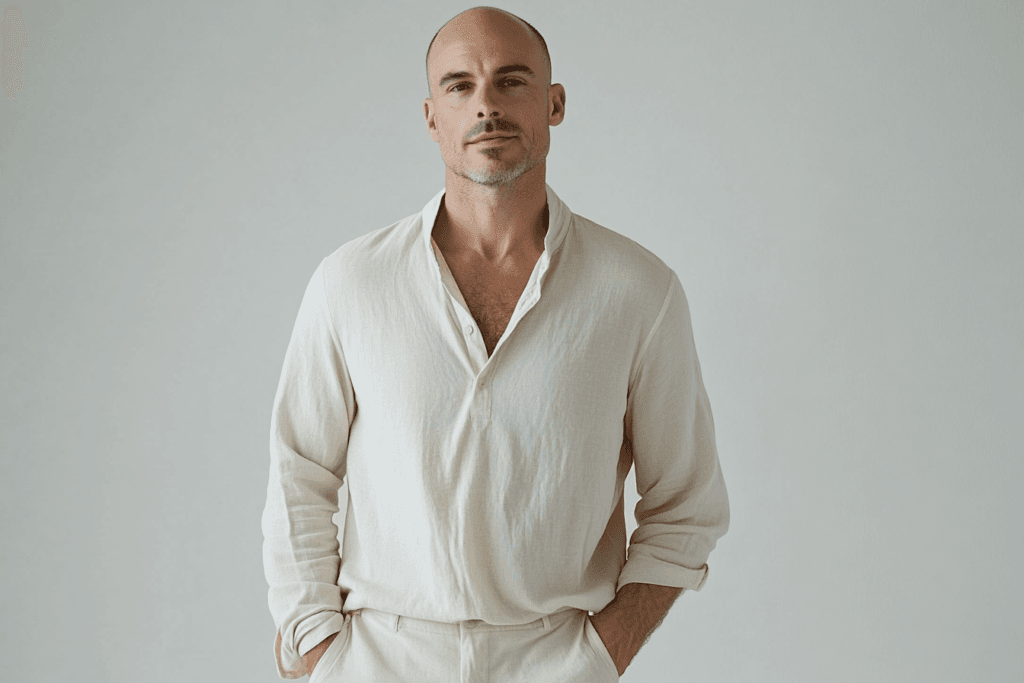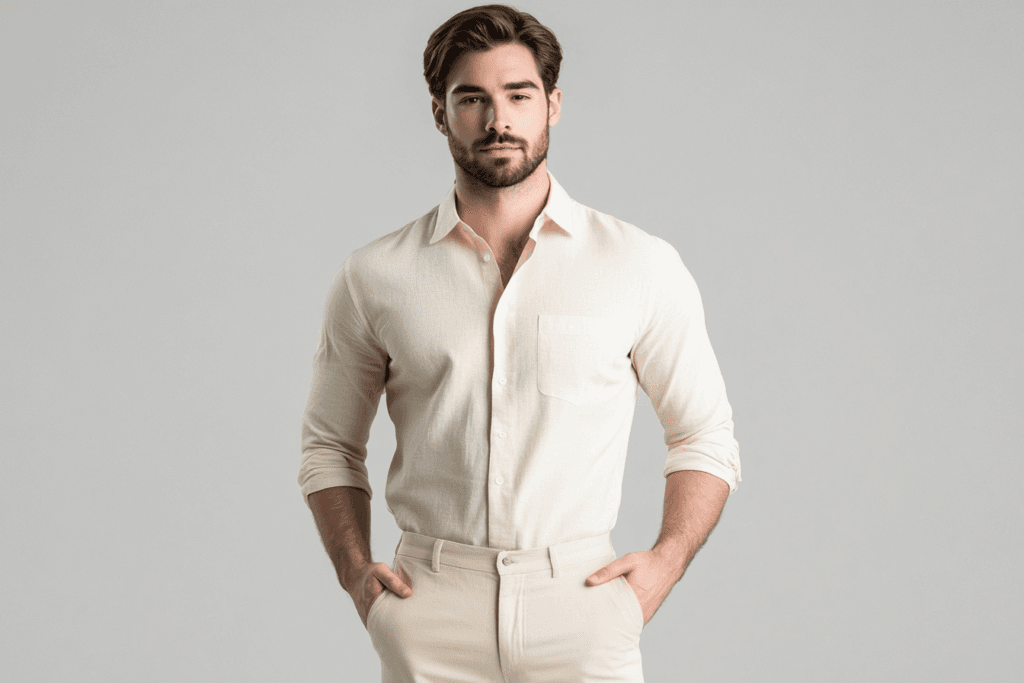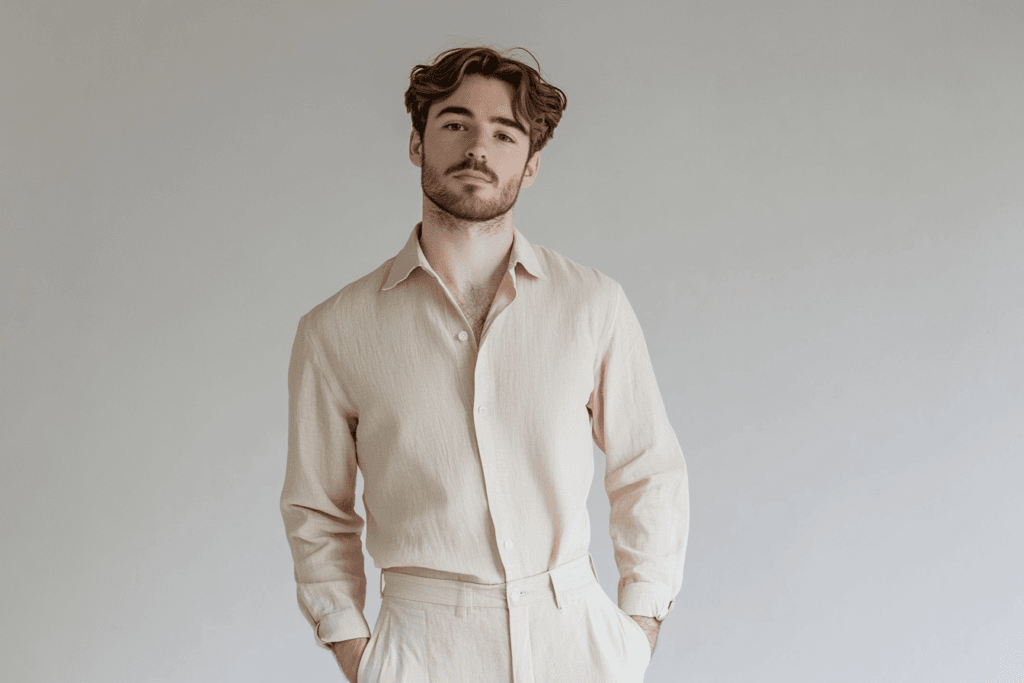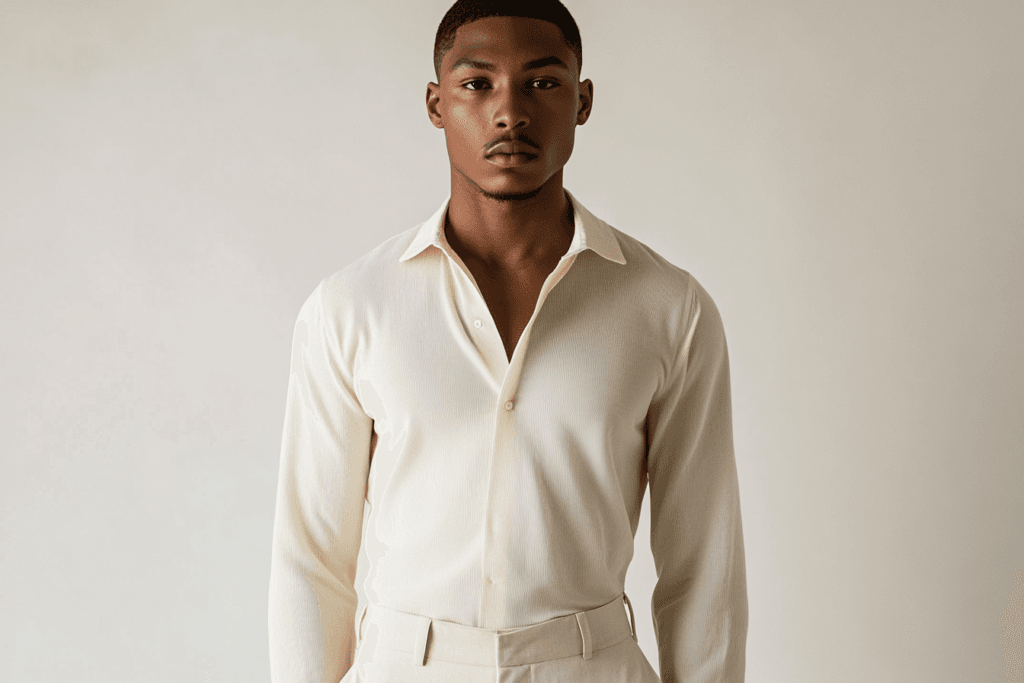
I’ve always been fascinated by how bamboo fabric feels so light and airy. Its unique fiber structure, filled with micropores and micro-gaps, allows air to flow freely.
This makes it 20% more breathable than cotton. Bamboo fabric also absorbs 60% more moisture than cotton and holds three times its weight in water. These qualities help sweat evaporate faster, keeping the body cool and dry.
Lab tests even show that bamboo fabric can regulate body temperature, keeping it 2-3°C cooler than the surrounding air. It’s no wonder bamboo fabric feels so refreshing, whether in hot weather or during physical activity.
Key Takeaways
- Bamboo fabric lets air pass 20% better than cotton.
- Its tiny fibers soak up 60% more sweat than cotton.
- This keeps you dry and comfy in heat or workouts.
- Bamboo fabric cools your body, staying 2-3°C cooler than air.
- It stops skin problems by letting sweat dry fast.
- Bamboo pulls moisture away, great for hot, sticky weather.
- It stays strong and works well even after many washes.
- Bamboo is gentle on skin, perfect for people with allergies.
- Picking eco-friendly bamboo, like lyocell, helps the planet too.
Why Breathability Matters in Fabrics?

The Role of Breathability in Comfort
I’ve always noticed how much more comfortable I feel when wearing breathable fabrics. Breathability plays a huge role in how fabrics interact with our bodies. When a fabric allows air to flow freely, it prevents heat from building up. This keeps me cool and reduces the sticky feeling that comes with sweat. Imagine wearing a shirt that traps heat and moisture—it’s uncomfortable and distracting, especially on a hot day.
Breathable fabrics also help prevent skin irritation. When sweat stays on the skin for too long, it can lead to chafing or even rashes. Fabrics like bamboo fabric excel here because they allow sweat to evaporate quickly. This keeps the skin dry and comfortable, even during intense activities. I’ve found that breathable materials make a noticeable difference in how I feel throughout the day, whether I’m working out or just running errands.
Moisture-Wicking and Temperature Regulation Benefits
One of the most impressive features of breathable fabrics is their moisture-wicking ability. Bamboo fabric, for example, naturally pulls moisture away from the skin and releases it into the air. This process keeps the body dry and prevents the discomfort of damp clothing. I’ve read that this is especially useful in humid climates, where staying dry can feel impossible. Unlike cotton, which tends to hold onto moisture, bamboo fabric excels at keeping me cool and dry.
Temperature regulation is another key benefit. Breathable fabrics like bamboo help maintain a stable body temperature by improving airflow and reducing heat retention. I’ve experienced this firsthand when wearing bamboo clothing during summer hikes. The fabric kept me cooler than other materials, even under the blazing sun. Studies show that bamboo fabric can absorb and release moisture efficiently, which helps regulate body temperature. This makes it a great choice for activewear or bedding, where comfort is essential.
Breathable fabrics also stand out for their durability. They maintain their moisture-wicking properties over time, even after multiple washes. This means I can rely on them for long-term comfort and performance. Whether I’m exercising, traveling, or just relaxing at home, I always reach for breathable fabrics like bamboo to stay comfortable and fresh.
What is The Unique Properties of Bamboo Fabric?

Micropores and Micro-Gaps in Bamboo Fibers
I’ve always been amazed by how bamboo fabric feels so light and breathable.
This unique quality comes from the microscopic structure of bamboo fibers. These fibers contain tiny gaps and holes, often called micropores and micro-gaps.
They allow air to circulate freely through the fabric. This natural ventilation keeps me cool and comfortable, even on the hottest days.
Here’s what makes bamboo fabric stand out:
- The microscopic gaps in bamboo fibers enhance airflow, making it easier for heat to escape.
- These gaps also improve ventilation, which helps regulate body temperature.
- Compared to other fabrics, bamboo’s structure allows for better air circulation, which I’ve noticed makes a big difference in how fresh I feel.
This unique fiber structure is why bamboo fabric is so breathable. It’s like wearing a built-in cooling system that works with your body.
Moisture-Wicking and Absorption Capabilities
One of the things I love most about bamboo fabric is how well it handles moisture. It actively pulls sweat away from my skin and moves it to the outer layers of the fabric. This allows the moisture to evaporate quickly, keeping me dry and comfortable. Unlike cotton, which tends to hold onto moisture, bamboo fabric excels at keeping me feeling fresh.
Here are some impressive facts about bamboo fabric’s moisture-wicking abilities:
- It can absorb 60% more moisture than cotton.
- Bamboo fabric holds up to three times its weight in water, which helps sweat evaporate faster.
- This moisture management keeps the body 2-3°C cooler than the surrounding air.
I’ve noticed this feature is especially helpful during workouts or in humid weather. The fabric keeps me dry and prevents that sticky, uncomfortable feeling.
Thermoregulation and Body Temperature Control
Bamboo fabric doesn’t just keep me cool; it also adapts to different temperatures. This adaptability makes it a great choice for year-round comfort. During summer, it helps me stay cool by promoting airflow and allowing sweat to evaporate. In winter, it provides a cozy warmth by retaining just the right amount of heat.
Here’s how bamboo fabric supports thermoregulation:
- It draws moisture away from the skin, enhancing airflow and keeping the body cool.
- The fabric adjusts to body temperature, making it suitable for both hot and cold weather.
- Its breathability and moisture-wicking properties work together to maintain comfort in varying conditions.
I’ve found that bamboo fabric is perfect for activewear and bedding. It keeps me comfortable no matter the season, making it a versatile and reliable choice.
Whatis the difference?Bamboo Fabric vs. Other Fabrics

Bamboo vs. Cotton: Airflow and Moisture Management
I’ve always found bamboo fabric to be far superior to cotton when it comes to breathability and moisture management. Bamboo fabric’s microscopic gaps allow for better airflow, making it 20% more breathable than cotton. This means it keeps me cooler and more comfortable, especially in hot weather. Cotton, while breathable, doesn’t match bamboo’s efficiency in this area.
When it comes to moisture absorption, bamboo fabric truly shines. It absorbs 60% more moisture than cotton and can hold up to three times its weight in water. This helps sweat evaporate faster, keeping my skin dry and preventing that sticky feeling. Cotton, on the other hand, tends to retain moisture, which can lead to discomfort over time.
Here’s a quick comparison:
| Measurement Type | Bamboo Fabric | Cotton Fabric |
|---|---|---|
| Moisture Absorption | Soaks up 60% more moisture | Standard absorbency |
| Weight Retention | Holds three times its weight in water | Less retention |
| Breathability | 20% more breathable | Standard breathability |
| Temperature Regulation | 2-3°C cooler than surrounding air | Standard temperature regulation |
Bamboo vs. Polyester: Heat Retention and Breathability
Polyester has always felt less breathable to me compared to bamboo fabric. While polyester traps heat and moisture, bamboo fabric excels at allowing air to flow freely. This makes bamboo a much better choice for staying cool and comfortable. Studies show that increasing bamboo content in fabric blends improves air permeability and reduces thermal resistance.
Another key difference lies in moisture-wicking. Bamboo fabric naturally pulls sweat away from the skin and allows it to evaporate quickly. Polyester, while often marketed as moisture-wicking, doesn’t perform as well in humid conditions. I’ve noticed that polyester tends to feel clammy after prolonged wear, whereas bamboo fabric keeps me dry and fresh.
Here’s how they compare:
| Fabric Type | Air Permeability | Thermal Resistance | Wicking Rate |
|---|---|---|---|
| Bamboo/Polyester Blend | Higher | Low | Higher |
I’ve also read that higher bamboo content in blends increases water vapor permeability and reduces heat retention. This makes bamboo fabric a clear winner for breathability and comfort.
Bamboo vs. Linen: Softness and Moisture-Wicking
Linen is another breathable fabric, but I’ve found bamboo fabric to be softer and more versatile. While linen has a coarse texture, bamboo fabric feels smooth and gentle against the skin. This makes it a better option for people with sensitive skin or those who prefer a luxurious feel.
In terms of moisture-wicking, bamboo fabric outperforms linen. Bamboo actively absorbs and releases moisture, keeping me dry even in humid conditions. Linen, while breathable, doesn’t wick moisture as effectively. This can lead to dampness and discomfort during extended wear.
Here’s why I prefer bamboo fabric over linen:
- Bamboo fabric offers a softer, silkier texture.
- It wicks moisture more efficiently, keeping me dry and comfortable.
- Bamboo’s thermoregulating properties make it suitable for all seasons, while linen is best for warm weather.
For me, bamboo fabric combines the best of both worlds: breathability and softness. It’s a versatile choice that works well for clothing, bedding, and more.
What Do Scientific Studies Reveal About Bamboo Fabric?

Research on Bamboo Fabric’s Breathability
I’ve always been curious about what makes bamboo fabric so breathable. Scientific studies reveal that its unique fiber structure plays a significant role. Bamboo fibers contain microscopic gaps that enhance air circulation. These gaps allow heat to escape and fresh air to flow through, creating a cooling effect. This natural ventilation makes bamboo fabric 20% more breathable than cotton.
Another fascinating aspect is its moisture-wicking ability. Bamboo fabric absorbs 60% more moisture than cotton and holds up to three times its weight in water. This helps sweat evaporate faster, keeping the body cool and dry. I’ve read that this property also helps regulate body temperature, maintaining it 2-3°C cooler than the surrounding air.
Quantitative studies back these claims with measurable results. For example, fabrics with bamboo content show higher air permeability and moisture management capabilities compared to pure cotton. Here’s a comparison:
| Fabric Type | Air Permeability | Thermal Resistance | Wicking Rate | Relative Water Permeability |
|---|---|---|---|---|
| 30 s Ne c cotton (warp) / 30 s Ne c bamboo (weft) | Higher | Very low | Higher | Higher |
| 30 s Ne c cotton (warp and weft) | Lower | N/A | N/A | Lower |
This data highlights how bamboo fabric outperforms traditional materials in breathability and moisture control. I’ve noticed these benefits firsthand, especially during workouts or in humid weather.
Expert Opinions and Real-World Testing
Experts often praise bamboo fabric for its breathability and comfort. They emphasize its natural moisture-wicking properties, which efficiently absorb and release moisture from the skin. This keeps the body cool and dry, even in challenging conditions. I’ve found this particularly useful during summer hikes, where staying comfortable can be a challenge.
Real-world tests also confirm bamboo fabric’s superior performance. Its microscopic gaps enhance breathability by facilitating air circulation and temperature regulation. This means the fabric not only keeps me cool in warm weather but also provides warmth in cooler climates. I’ve experienced this versatility with bamboo bedding, which feels cozy in winter and refreshing in summer.
Here’s another interesting finding: increasing bamboo content in fabric blends improves both air permeability and moisture management. This makes bamboo fabric a top choice for activewear and bedding.
| Blend Composition | Air Permeability | Moisture Management Capability |
|---|---|---|
| Increased bamboo and cotton content | Increased | Increased |
These insights show why bamboo fabric stands out. Its breathability, moisture-wicking properties, and adaptability make it a reliable option for comfort across various climates.
How to Choose the Right Bamboo Fabric?

Types of Bamboo Fabric: Viscose, Lyocell, and Linen
When I first explored bamboo fabric, I discovered that not all types are the same. Each type has unique characteristics that suit different needs. Here’s a breakdown of the most common types:
- Bamboo Viscose: This is the most popular type of bamboo fabric. It feels incredibly soft and durable, making it perfect for everyday clothing and bedding. However, I’ve learned that its production process involves chemical treatments, which can harm the environment.
- Lyocell Bamboo: This type stands out for its eco-friendliness. It retains much of bamboo’s natural composition during production, which minimizes environmental impact. While it’s slightly less thermally stable than viscose, I find it ideal for breathable and sustainable clothing.
- Fine Bamboo (Bamboo Linen): This type has a coarser texture due to its labor-intensive production process. It’s less soft than viscose or lyocell but works well for applications like upholstery or summer wear.
- Organic Bamboo Rayon: This variant of viscose is produced under eco-friendly standards. It combines the softness of viscose with a more sustainable production process.
Each type offers unique benefits. For example, bamboo viscose feels luxurious, while lyocell bamboo appeals to those seeking greener options. I always consider my priorities—whether it’s softness, sustainability, or durability—when choosing the right type.
Identifying High-Quality Bamboo Fabric
Finding high-quality bamboo fabric can feel overwhelming, but I’ve learned a few tips to make the process easier. First, I always check for certifications that guarantee quality and sustainability. Here’s a helpful table of certifications to look for:
| Certification Standard | Description |
|---|---|
| FSC®-certification | Ensures responsible forestry practices for bamboo products. |
| EN17009 | Sets safety, health, and environmental standards for bamboo materials. |
| E1 norm (EN 717-1) | Guarantees low indoor emissions for healthier living spaces. |
| LEED & BREEAM | Recognizes contributions to green building certifications worldwide. |
These certifications give me confidence that the fabric meets high standards for both quality and environmental impact.
I also pay attention to the fabric’s texture and performance. High-quality bamboo fabric feels soft, almost like silk or cashmere. It should also wick moisture effectively and allow for excellent airflow. Here are some key features I look for:
- Softness: The fabric should feel smooth and gentle against the skin.
- Breathability: It should allow air to circulate freely, keeping me cool and comfortable.
- Moisture-wicking: The fabric should absorb and release moisture efficiently.
- Hypoallergenic: It should minimize irritation, especially for sensitive skin.
Lastly, I avoid standard viscose bamboo unless it’s labeled as organic or eco-friendly. Instead, I opt for lyocell bamboo or mechanically processed bamboo fabric, which are better for the environment. By following these guidelines, I can confidently choose bamboo fabric that aligns with my values and needs.
Bamboo fabric stands out for its breathability, thanks to its unique fiber structure. Its micropores and moisture-wicking properties keep me cool and dry, even in challenging conditions. Compared to cotton, polyester, and linen, bamboo fabric offers unmatched comfort and usability. I’ve noticed how it excels in hot climates, activewear, and bedding, making it a versatile choice for everyday life. Its ability to regulate temperature and manage moisture has transformed how I stay comfortable throughout the day.
Discover the refreshing difference bamboo fabric can bring to your lifestyle.
FAQ
What makes bamboo fabric more breathable than cotton?
Bamboo fabric has microscopic gaps in its fibers that allow better airflow. These gaps improve ventilation and help heat escape. Cotton lacks this unique structure, which makes bamboo fabric 20% more breathable. I’ve noticed this difference, especially in hot weather.
Is bamboo fabric suitable for sensitive skin?
Yes, bamboo fabric is hypoallergenic and gentle on the skin. Its smooth texture reduces irritation, making it ideal for people with sensitive skin. I’ve found it much softer and more comfortable than other fabrics like linen or polyester.
How does bamboo fabric regulate body temperature?
Bamboo fabric absorbs moisture and releases it into the air, which helps cool the body. It also adapts to temperature changes, keeping me warm in winter and cool in summer. This thermoregulating ability makes it perfect for year-round use.
Does bamboo fabric retain odors?
No, bamboo fabric resists odors naturally. Its moisture-wicking properties prevent sweat from lingering, which reduces odor buildup. I’ve noticed my bamboo clothing stays fresher for longer, even after intense workouts.
How do I care for bamboo fabric?
I wash bamboo fabric in cold water on a gentle cycle. I avoid harsh detergents and fabric softeners to maintain its softness. Air drying works best, but low-heat tumble drying is also fine. Following these steps keeps my bamboo items in great condition.
Is bamboo fabric eco-friendly?
Yes, bamboo fabric is sustainable when produced responsibly. Bamboo grows quickly without pesticides and requires less water than cotton. However, some production methods involve chemicals. I always look for eco-certified bamboo fabrics to ensure sustainability.
Can bamboo fabric replace polyester in activewear?
Absolutely! Bamboo fabric wicks moisture better and feels more breathable than polyester. It also resists odors and feels softer on the skin. I’ve switched to bamboo activewear for its superior comfort and performance during workouts.
What are the best uses for bamboo fabric?
Bamboo fabric works well for clothing, bedding, and towels. Its breathability and softness make it ideal for summer wear and activewear. I also love using bamboo sheets and pillowcases for a cool, comfortable sleep.
📝 Tip: Always check for certifications like FSC® or OEKO-TEX® when buying bamboo fabric to ensure quality and sustainability.
Related
1.Bamboo vs Cotton: Which is Better for Sensitive Skin? →
2.Bamboo vs Cotton- Sustainability, Comfort, Performance →
3.What Is Bamboo Textile? Exploring The Eco-Friendly Fabric →
4.A comparative study of mechanical and comfort properties of bamboo viscose as an eco-friendly alternative to conventional cotton fibre in polyester blended knitted fabrics →
5.Comfort and Mechanical Properties of Polyester/Bamboo and Polyester/Cotton Blended Knitted Fabric →
